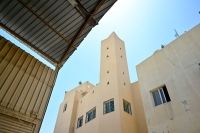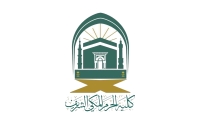
The King Abdul Aziz Endowment for Al-Ain Al-Aziziya is a Saudi charity and the namesake of the founding King Abdul Aziz bin Abdulrahman Al Saud, who endowed Al-Aziziya Spring to supply water to Jeddah Governorate. The Endowment works to sustain its assets and resources, innovates creative solutions for delivering its services to beneficiaries, and adheres to the highest professional standards in philanthropy. Ain Al-Aziziya's management headquarters is located in the Jeddah governorate a...

1927 The Founding King Abdulaziz Bin Abdulrahman Al Saud ordered the establishment of a dedicated facility for producing Al-Kaaba Al-Musharrafa's Kiswa in Ajyad district of Makkah Al-Mukarramah, marking the creation of the first Saudi-made Kiswa produced in Makkah Al-Mukarramah. 1962 Al-Kaaba Al-Musharrafa's Kiswa Factory was relocated to Jarwal Neighborhood in Makkah Al-Mukarramah. 1965 The first machine-made Kiswa for Al-Kaaba Al-Musharrafa was produced. 1972 King Faisal Bin Abdulaz...

Al-Qiblatayn Mosque is the mosque where the revelation descended upon Prophet Muhammad, peace be upon him (PBUH), to change the Qiblah from Bayt Al-Maqdis (in Jerusalem) to Al-Kaaba Al-Musharrafa, in the middle of the month of Sha’ban during the second year of the Hijrah. It is one of the historical and archaeological mosques in Al-Madinah Al-Munawwarah. The incident of the change of the Qiblah is linked to the visit of Prophet Muhammad (PBUH) to Umm Bishr from Banu Salama, to offer her condo...

The Rare Quran Manuscripts Exhibition is an exhibition showcasing a collection of rare Quran manuscripts featuring various scripts, designs, and artistic styles. It was organized by the King Abdulaziz Public Library in 2022 in Riyadh , the capital of the Kingdom of Saudi Arabia. Contents of the Rare Quran Manuscripts Exhibition The King Abdulaziz Public Library possesses a collection of rare Quran manuscripts, most of which were written between the sixteenth and nineteenth centuries, totaling 2...

The oldest audio recording of Quran recitation in the Grand Mosque in Makkah Al-Mukarramah , located west of the Kingdom of Saudi Arabia, dates back to 1885. It was recorded by the Dutch Orientalist and Muslim convert Christiaan Snouck Hurgronje using wax cylinders during his visit to Makkah Al-Mukarramah. This recording has been preserved by Leiden University in the Netherlands. ...

Al-Jafrah Mosque is one of the historic mosques of old Riyadh City . It was located southwest of Riyadh in Hillat al-Sharqiyah Neighborhood and was previously known as al-Hayza Mosque, named after the neighborhood in which it was situated. The entire neighborhood is now part of al-Hukm Palace complex. Imams and muezzins of al-Jafrah Mosque Al-Jafrah Mosque was demolished in the mid-1950s, erasing its landmarks. Among its imams was Sheikh Hamad Bin Faris, a scholar of Riyadh and the head of the ...

Al-Haram al-Makki College is an Islamic college located in the Grand Mosque in Makkah al-Mukarramah City , west of the Kingdom of Saudi Arabia. It is overseen by the General Authority for the Care of the Affairs of the Grand Mosque and the Prophet's Mosque. Graduates of al-Haram al-Makki Institute are given priority for admission, and students study at the undergraduate level. Establishment of al-Haram al-Makki College Al-Haram al-Makki College was established in 2015 under its new name af...

Zamzam water springs from Zamzam Well in the Grand Mosque in Makkah al-Mukarramah near al-Kaaba al-Musharrafa. Ultraviolet (UV) rays are used to sterilize Zamzam water by emitting energy generated by low-pressure mercury lamps enclosed in special glass. The process allows light to pass through bacteria, viruses, and microorganisms, penetrating their outer membranes and destroying their Deoxyribonucleic acid (DNA). The water is then directed into a cylindrical tube containing lamps that generate...

The Custodian of the Two Holy Mosques' Guests Program is a program aimed at hosting annually many Hajj and Umrah performers and visitors from the Islamic world and Muslim minorities in the world's countries. It is overseen by the Ministry of Islamic Affairs, Dawah, and Guidance . Launch of the Custodian of the Two Holy Mosques' Guests Program The program was launched in 1997 and it aimed to host Muslims from around the world to perform Hajj and Umrah rituals. The program offers r...

Seclusion (I'tikaf) in the Grand Mosque is a period of seclusion observed by worshippers who dedicate themselves to worship, remembrance, and recitation of the Quran, following the tradition of Prophet Muhammad, peace be upon him (PBUH). It begins in the last ten days of the month of Ramadan, from the twentieth day until the end of the Isha prayer on the night of Eid Al-Fitr. Organizing seclusion in the Grand Mosque The General Authority for the Care of the Affairs of the Grand Mosque and ...

Maqam Ibrahim is the ancient stone upon which Prophet Ibrahim, peace be upon him (PBUH), stood during the construction of Al-Kaaba Al-Musharrafa in Makkah Al-Mukarramah . The stone has undergone several developments and improvements over time, including: 777 The Maqam was adorned with a gold coating for the first time by the Abbasid Caliph Al-Mahdi. 851 The Maqam was gilded for the second time by Al-Mutawakkil ala Allah. 865 It was also gilded during the caliphate of Al-Mutawakkil, and in 870,�...

The Holy Site of Arafat is surrounded by a semicircle of mountains, with a plain in the center, bounded by Uranah Valley on several sides. It is located on the road connecting Makkah al-Mukarramah City and Taif Governorate , about twenty-two km east of Makkah al-Mukarramah, six km from Muzdalifah Site , and ten km from Mina Site . Arafat Site is the only Holy Site outside the boundaries of the Grand Mosque . It is a flat plain containing Mount Arafat, known as Jabal al-Rahmah , which reaches th...